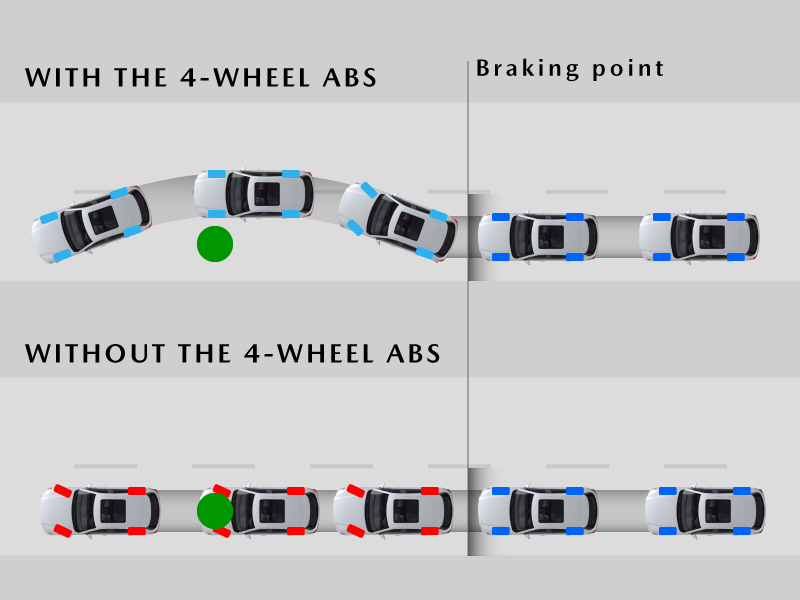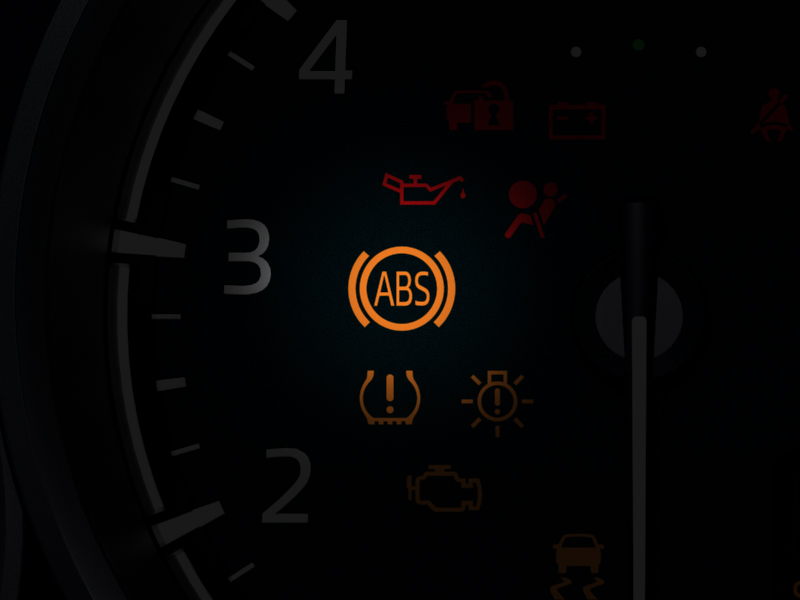What Is an Anti-lock Braking System (ABS)?
Anti-lock braking systems help drivers maintain control of their vehicles during emergency braking situations.
What is ABS?
Imagine a scenario in which you need to hit the brakes urgently and forcefully. Without ABS, the grip of the brake pads surpasses the grip the tires have on the road. As a result, your tires will stop turning, but momentum will continue to push your vehicle forward, causing it to slip or skid and making it near impossible to steer.
To combat this phenomenon, drivers were once taught to “pump their brakes” (also called cadence braking or stutter braking) in emergency braking situations instead of just slamming their foot onto the pedal. Doing so allowed a vehicle’s tires to continue to rotate, making it possible to steer and avoid a collision.
But remembering to pump the brakes when there are only a few seconds to respond to something happening on the road is difficult, even for professional drivers.
Anti-lock braking systems monitor your vehicle’s individual wheels and keep them from locking up during hard braking by pulsing the brakes several times per second. These systems, as we know them today, gained popularity in the mid-to-late 20th century, but their installation in all new passenger vehicles became legally required by the National Highway Traffic Safety Administration (NHTSA) as of September 1st, 2011.
How does ABS work?
An anti-lock braking system uses four basic components: speed sensors, valves, a pump, and a controller. There are several types of ABS, but in a four-wheel system:
1. Speed sensors present at each wheel measure rotational speed.
2. This information is then sent to the controller, which compares the speed of each wheel to the vehicle's speed.
3. If the controller detects that one or more wheels are slowing down too quickly or have stopped rotating altogether, it sends a signal to the valve.
4. The valve reduces the pressure in that wheel’s brake line to prevent the wheel from locking up.
5. The pump then restores the pressure in the brake line once the wheel regains traction, and the valve releases the brake pressure.
6. This process repeats multiple times per second until the vehicle comes to a stop.

Put more simply, ABS sensors monitor wheel speed. If a driver brakes hard, a computer-controlled hydraulic system can rapidly pulse the brakes multiple times per second to prevent them from locking up. This can allow the driver to maintain control of the vehicle and steer around obstacles while still braking effectively.
How do I use ABS?
Anti-lock braking systems are engaged automatically when a driver slams on the brake or, in some cases, when the sensors pick up on tires skidding across a wet or loose surface.
When pressing firmly on the brake in these situations, the driver can tell ABS has activated when they feel a rapid pulsing through the brake pedal, as though the pedal is pushing back. Drivers may also hear a grinding, buzzing, or groaning noise.
These are signals that ABS is working – not that your brakes have failed.
How can I tell if my vehicle has ABS?
Many vehicles with ABS have an icon on the instrument panel of the dashboard that looks something like the one below. It should illuminate as part of a “bulb-check” function when the vehicle is initially turned on.

If your ABS light turns on while you’re driving or does not extinguish after the bulb check, that indicates there is likely an issue with the system and that you should take your vehicle in to be serviced.
Should you not see this icon or something similar to it on your dash, check your Owner’s Manual or speak to your dealer to verify whether or not your vehicle has ABS.
Advantages of ABS
● Effective braking: Anti-lock brakes help to prevent the wheels from locking up during emergency braking, allowing the driver to apply maximum braking force without skidding.
● Better overall traction: ABS can help prevent skidding and sliding by ensuring the wheels maintain traction on wet or gravel surfaces.
● Reliable performance: ABS can help ensure that the braking system is functioning properly through a self-diagnostic feature that checks for any faults or malfunctions.
● Improved driver control: With ABS, drivers can maintain steering control even during hard braking to avoid obstacles or hazards on the road.
According to a 2009 study performed by NHTSA based on data collected between 1995 and 2007, ABS reduced the crash involvement rate of non-fatal crashes, collisions with pedestrians, and collisions with vehicles on wet roads, although it did not improve the rate of crashes involving fatal run-off-road collisions.
More ABS FAQs
What are other names for ABS?
The most common names and terminology used to describe an anti-lock braking system include anti-skid braking system, anti-lock brakes, and, of course, ABS. Different car brands sometimes use proprietary names for their anti-lock braking systems, although this is less common today. ABS is not to be confused with electronic stability control (ESC) or traction control (TC), which we discuss more extensively in our article on car safety features.
Does ABS decrease stopping distance?
Four-wheel ABS can decrease stopping distance on dry pavement, is most beneficial on wet or slippery roads, but may actually increase stopping distance on gravel or loosely packed snow.
Do you need to pump the brakes with ABS?
No. ABS is designed to rapidly pulse the brakes automatically during an emergency braking situation. Drivers should apply firm and continuous pressure on the brake pedal and focus on steering their vehicle to safety.
Do all cars have ABS?
ABS is a standard safety feature on most passenger vehicles, trucks, and SUVs made after September 1st, 2011. It is, for example, standard on all new Mazda vehicles, from the Mazda CX-5 to the Mazda CX-30 to the CX-90 and CX-70 PHEVs.
Why is my ABS light on?
When your ABS light comes on, it could signal a variety of potential issues, including a malfunctioning ABS module, low fluid reservoir levels, or dysfunctional or obstructed wheel speed sensors. Have the vehicle serviced by a qualified mechanic to ensure that your vehicle's ABS is working properly.
Safety at Mazda
At Mazda, we want our drivers to feel confident and safe behind the wheel. While safe driving is key, our vehicles offer an array of safety features and technologies like ABS that can help prevent accidents and protect drivers, passengers, and pedestrians alike.
To learn more about safety at Mazda, check out our safety features and IIHS-awarded vehicles online or schedule a visit with a local Mazda Dealer today.
This article is intended for general informational purposes only and is based on the latest competitive information available at the time of posting. Information herein is subject to change without notice and without Mazda incurring any obligations. Please review a variety of resources prior to making a purchasing decision. Visit Resource Center for more articles.





















